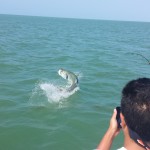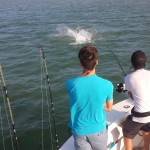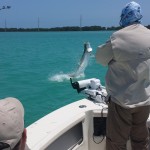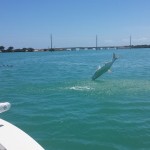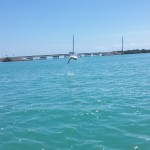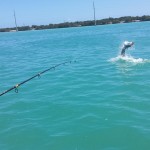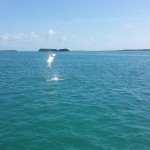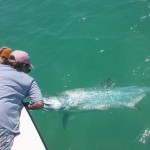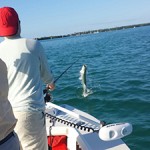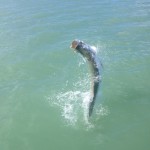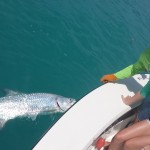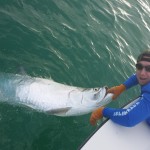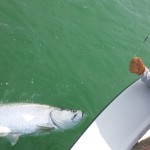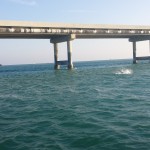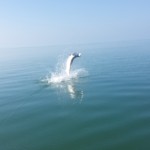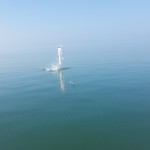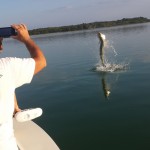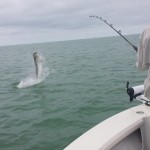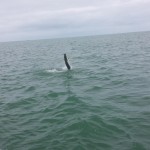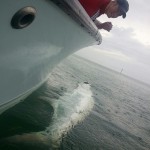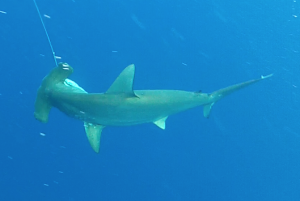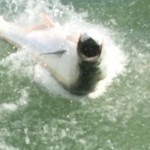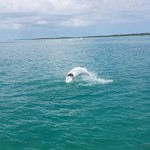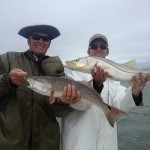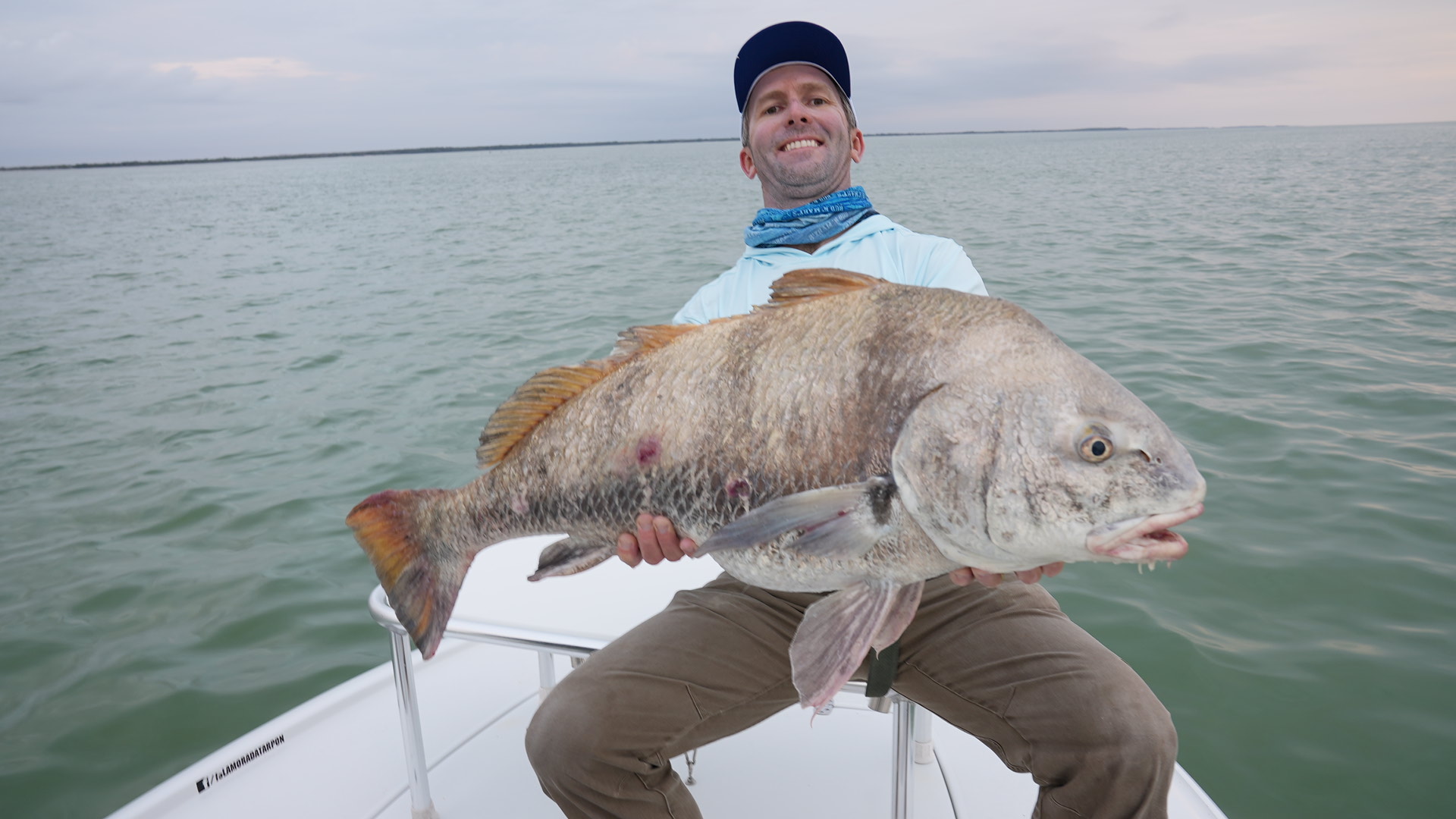The april islamorada tarpon fishing bite has continued to stay strong throughout the month. We’ve been catching fish on every trip really. I think I only had one trip where we fished a half day due to a cold front and caught fish on the patches, only giving the tarpon a try for the last hour, where we did not hook at least one tarpon. And only one other trip where we did not land a tarpon (we had two tarpon break us off in the bridges). That’s great fishing! We average probably two fish landed a trip, when you average the good ‘banner’ days where we release 3, 4, or more. We’ve had a share of 1 fish landed trips in early april as we had a bit of a lull in the numbers of tarpon around, though the last week we’ve seen plenty more show up. I think we had such a good early start that fish showed up strong in february and march, leading to a lull in early April which is traditionally considered ‘peak’ season. Every year is different but like I said the last week seems to have seen big numbers around town again. The backcountry has been a little slow with the tarpon since the last front, but they can show back up there any time again too I think when the wind stops blowing and some of the nasty ‘red weed’ that has been plaguing us back there dissipates. Look for May to be stay strong that is often the best month of the year for tarpon and the weather stays consistently warm. Summer can be very good too, last year July was just about as consistent as April with the early mornings being very good in the backcountry as well as good fishing around town on the evening trips with much less pressure on the fish since it is a bit slower with business and boats then. I have some evenings available over the next couple months, just about every day is booked until June, but tarpon is what I’m doing and if your looking to catch one now is the time!
Capt. Rick Stanczyk
4/3/14 April Islamorada Tarpon Fishing Report
It’s April and the tarpon have made their presence known here in Islamorada and throughout the Florida Keys. Islamorada tarpon fishing is the big thing here for the next several months. We’ve had a great early season and the weather is now really getting right for a big month in April. Plenty of big schools of baitfish (mullet) have been showing up, several big ‘balls’ of thousands at a time that we use for bait. The last few days I’ve been having great action fishing live mullet for tarpon. We’ve had 6 fish to the boat in the last 3 trips, and over another fifteen or so that didn’t quite make it there! Lots of other fish boiling, flashing, and busting the baits that weren’t hooked too. It’s game on here for april tarpon fishing in Islamorada. The fishing should only get better. I’m booked most every day but I do have evening trips available that go from 4 to 8 PM so check with me. It is a great time to go after big tarpon and the bite around sunset usually goes off! You can see from the pictures below we’ve been having wild action the last month, and as stated before April only gets better. The weather usually stabilizes and the big schools of migrating fish show up along with the schools of mullet. It’s a mixture for tarpon craziness that you don’t want to miss! Drop me a line lets get you hooked up to the fish of a life time!
3/25/14 Offshore fishing in Islamorada on the Bn’M II
It’s been a busy month here while offshore fishing in Islamorada. March is a transitional month and there’s been a little bit of everything. We have caught grouper, wahoo, mackerel, mahi, tiger shark, hammerhead shark, yellowtail snapper, mutton snapper, golden tilefish, blueline tilefish, blackfin tun, amberjack, barracuda, swordfish, etc! Some days have been slower than others, but hey, that’s why they call it fishing. The slower days make you really appreciate the good days. We are still fishing on the reef quite a bit, but the next few weeks we will really focus on going “offshore” further, out into the gulf stream looking for more pelagic species. One of the most exciting things lately has been vertical jigging with tormenter tackle for big amberjacks, some over 50 lbs on spinning jigging outfits! Send me an email when you’re ready to go give it a shot! bnmcharters@gmail.com
Capt. Nick Stanczyk
3/5/14 March Islamorada Fishing Report Florida Keys
Well it’s spring time here in Islamorada and that means we are kicking off with march fishing in islamorada. For myself that usually means starting to target larger things – tarpon, sharks, mud marlin, goliath grouper, and more. Most of February the tarpon fishing in the florida keys area we fish was fairly good. We caught fish just about every day we tried for them aside from a couple. However this time of year can be hit or miss especially when we have late season cold fronts, that really turns tarpon off. We did have a few banner days, one day we had 6 nice tarpon to the boat between 60 and 90 lbs. Most days however we are getting a variety of sharks, the occasional large ‘mud marlin’, and a handful of tarpon bites. Tarpon have been biting a bit around town locally too if you can get fresh mullet like we have been, that can be a good option. Evening tarpon trips are a possibility, again though warm weather is key. Looks like we have a minor front coming in this weekend so that may slow the tarpon bite down but it will likely pick up again quick as it’s not getting too cold. Other than tarpon we’ve been doing a lot of trout and snapper fishing in the bays. Lots of juvenile trout showing up from the gulf with some larger ones mixed in. The gulf is also a good option this time of year, I haven’t been out there much but this time of year tripletail are often out there plus some cobia, goliaths, and more on the wrecks.
2/2/14 February Islamorada Fishing Report Update
Well it’s February fishing in Islamorada and that means we are getting into our ‘busy season’. Spring offers the most variety of fish as you have a shot at catching just about anything at this time. Today I wanted to let you all know we tarpon fished as it’s been warm for several days and looks to continue to be throughout the week. This is a perfect recipe for early tarpon fishing in the Florida Keys as big groups of migrating tarpon come in from the gulf. We had some luck and caught 2 big tarpon in the 80-100 lb range plus several black tip sharks on a half day of fishing. Mullet muds are found pretty easily throughout the bay so bait can be caught first thing in the morning many days. Before the last few days of nice weather we had a mild cold front with some rain and cloudy weather, though fishing was good. We had a fun day with close to 20 snook, a dozen reds, and a few other fish. Fishing the mainland ‘cape’ areas as well as some of the backcountry flats. Give me a call or email if your looking to get hooked up to big fish, the spring time is a great time to go fishing in Islamorada and February is often the start of that!

